Financial Statement Analysis of Commonwealth Bank of Australia Report
VerifiedAdded on 2023/01/23
|9
|1900
|90
Report
AI Summary
This report provides an in-depth analysis of the Commonwealth Bank of Australia's (CBA) financial statements and annual reports. It begins with an executive summary highlighting the company's compliance with financial reporting requirements, followed by a detailed examination of the company's background, including its market position and past issues. The report analyzes the basic structure of the annual report, including the director's report and remuneration, and assesses the corporate governance report based on Australian Stock Exchange principles. It also evaluates CBA's compliance with Australian Accounting Standards Board (AASB) standards, particularly AASB107 and AASB7. Furthermore, the report discusses the application of the prudence concept within the conceptual framework. The analysis concludes with recommendations based on the findings and includes a comprehensive reference list.

1
Sociology
Sociology
Paraphrase This Document
Need a fresh take? Get an instant paraphrase of this document with our AI Paraphraser
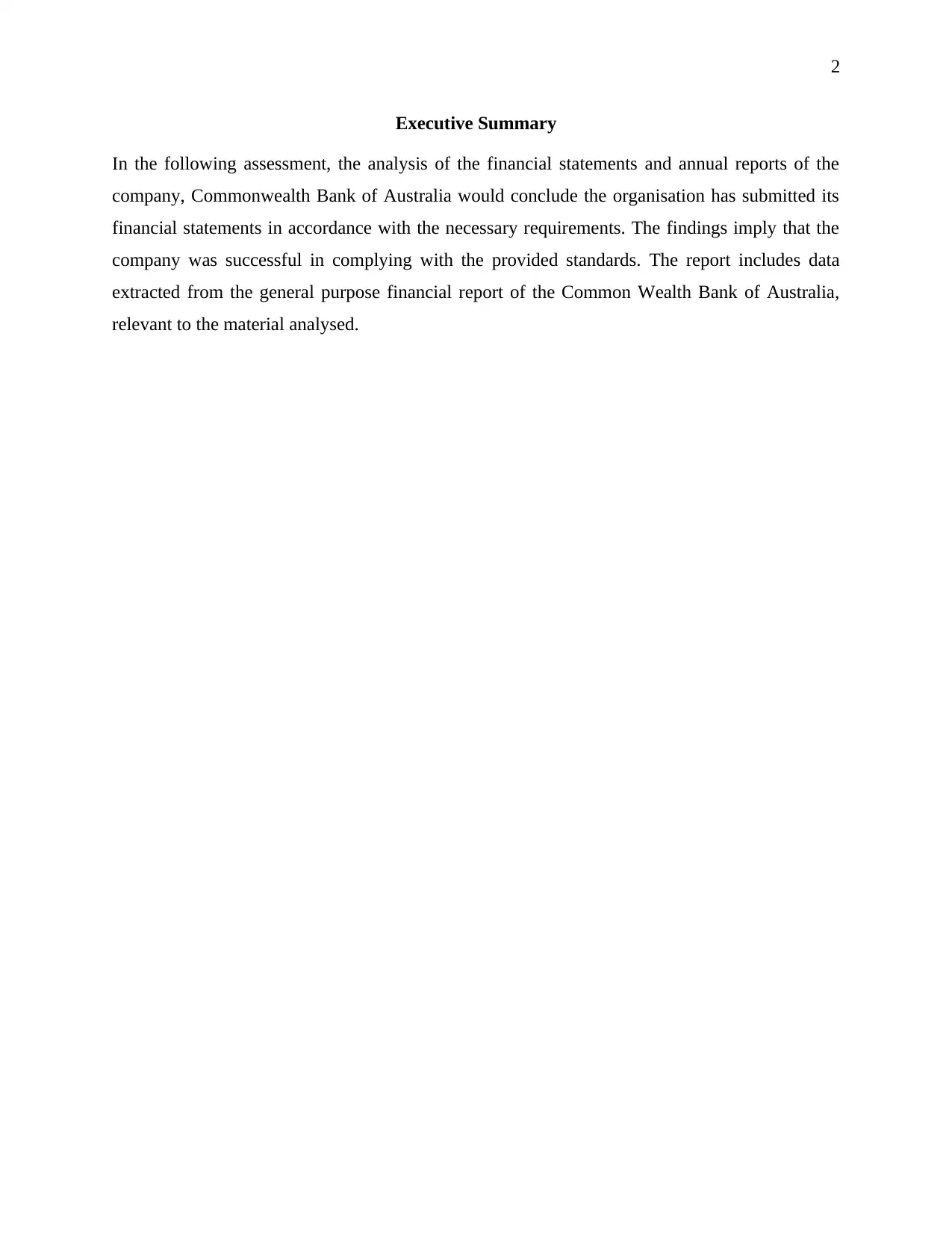
2
Executive Summary
In the following assessment, the analysis of the financial statements and annual reports of the
company, Commonwealth Bank of Australia would conclude the organisation has submitted its
financial statements in accordance with the necessary requirements. The findings imply that the
company was successful in complying with the provided standards. The report includes data
extracted from the general purpose financial report of the Common Wealth Bank of Australia,
relevant to the material analysed.
Executive Summary
In the following assessment, the analysis of the financial statements and annual reports of the
company, Commonwealth Bank of Australia would conclude the organisation has submitted its
financial statements in accordance with the necessary requirements. The findings imply that the
company was successful in complying with the provided standards. The report includes data
extracted from the general purpose financial report of the Common Wealth Bank of Australia,
relevant to the material analysed.
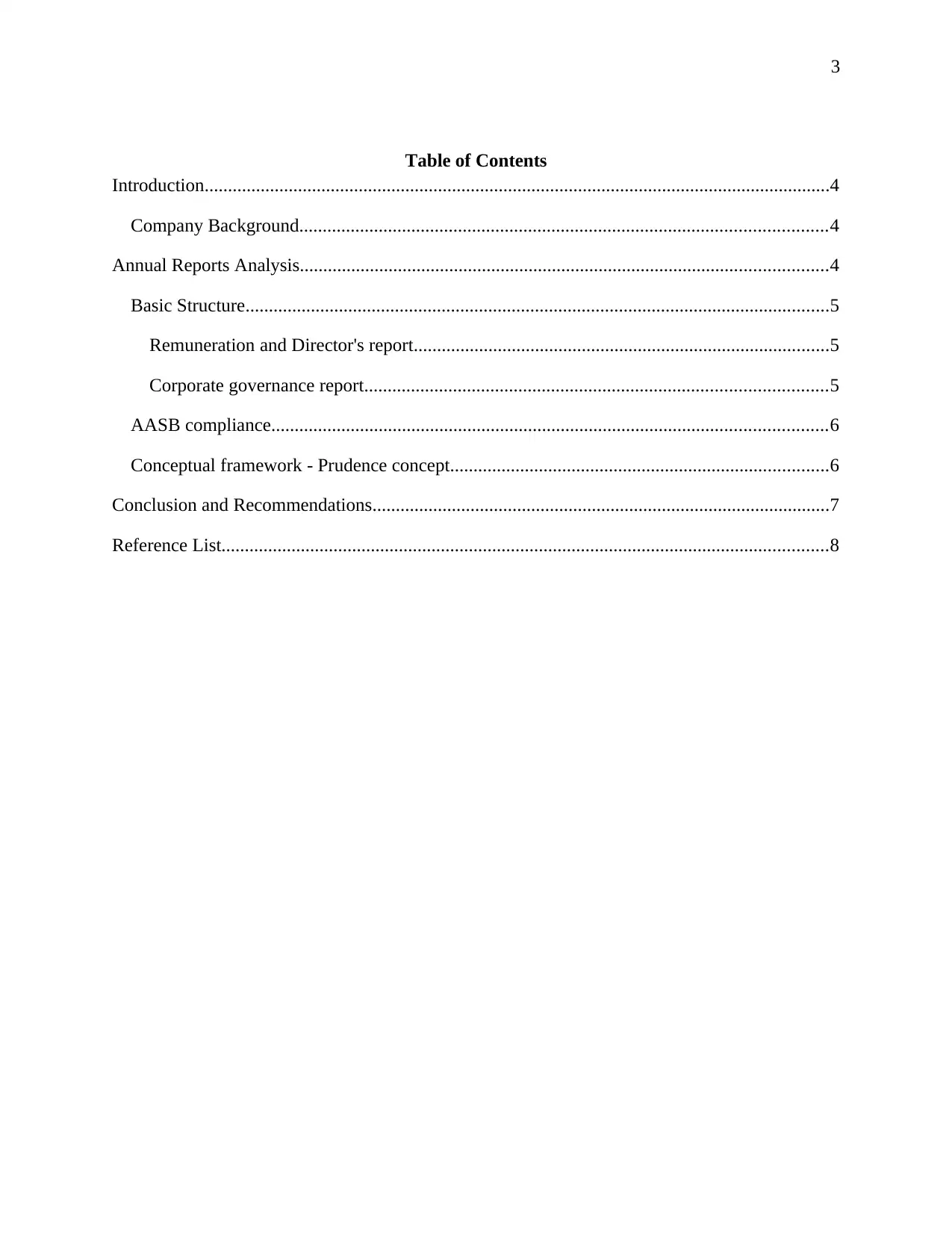
3
Table of Contents
Introduction......................................................................................................................................4
Company Background.................................................................................................................4
Annual Reports Analysis.................................................................................................................4
Basic Structure.............................................................................................................................5
Remuneration and Director's report.........................................................................................5
Corporate governance report...................................................................................................5
AASB compliance.......................................................................................................................6
Conceptual framework - Prudence concept.................................................................................6
Conclusion and Recommendations..................................................................................................7
Reference List..................................................................................................................................8
Table of Contents
Introduction......................................................................................................................................4
Company Background.................................................................................................................4
Annual Reports Analysis.................................................................................................................4
Basic Structure.............................................................................................................................5
Remuneration and Director's report.........................................................................................5
Corporate governance report...................................................................................................5
AASB compliance.......................................................................................................................6
Conceptual framework - Prudence concept.................................................................................6
Conclusion and Recommendations..................................................................................................7
Reference List..................................................................................................................................8
⊘ This is a preview!⊘
Do you want full access?
Subscribe today to unlock all pages.

Trusted by 1+ million students worldwide
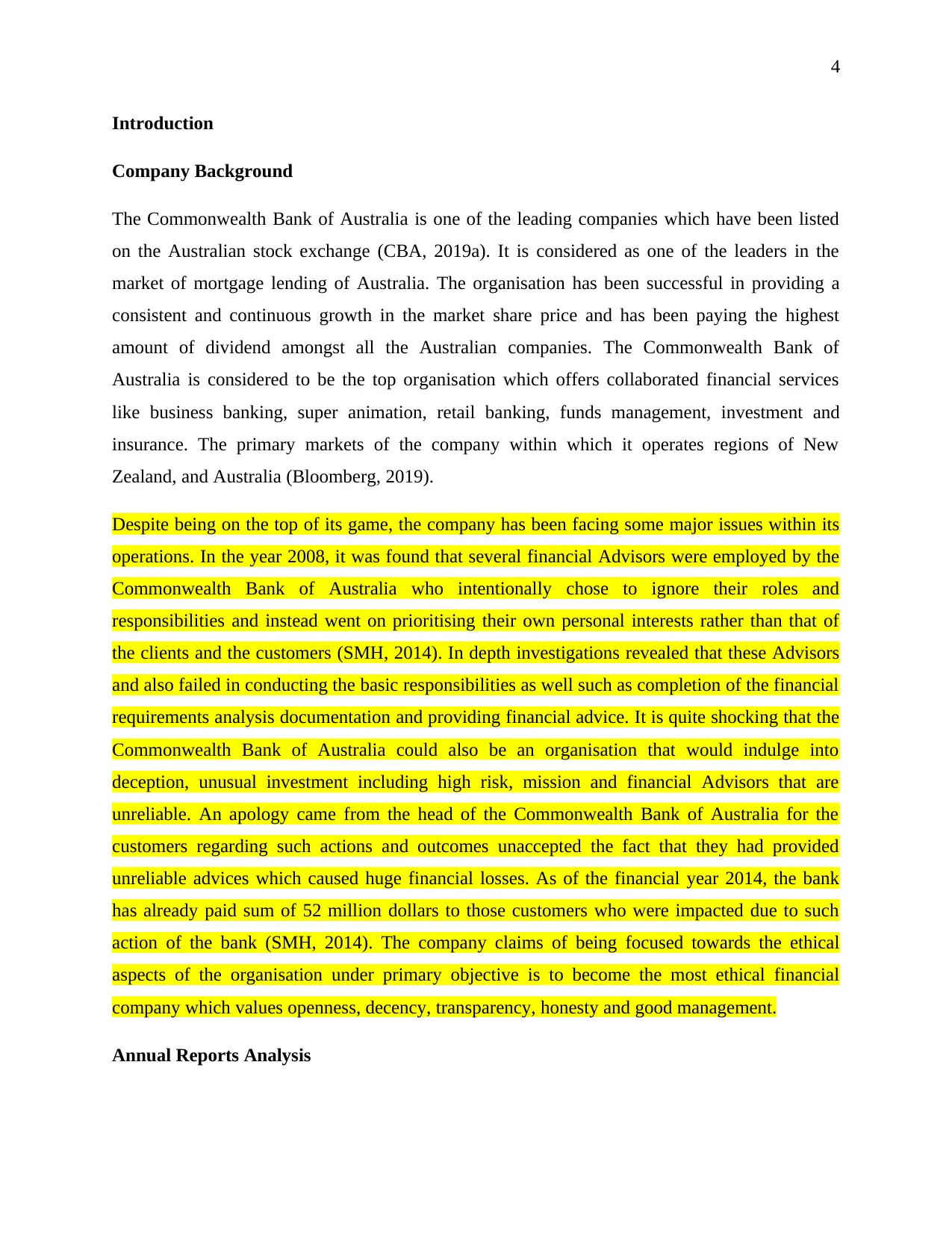
4
Introduction
Company Background
The Commonwealth Bank of Australia is one of the leading companies which have been listed
on the Australian stock exchange (CBA, 2019a). It is considered as one of the leaders in the
market of mortgage lending of Australia. The organisation has been successful in providing a
consistent and continuous growth in the market share price and has been paying the highest
amount of dividend amongst all the Australian companies. The Commonwealth Bank of
Australia is considered to be the top organisation which offers collaborated financial services
like business banking, super animation, retail banking, funds management, investment and
insurance. The primary markets of the company within which it operates regions of New
Zealand, and Australia (Bloomberg, 2019).
Despite being on the top of its game, the company has been facing some major issues within its
operations. In the year 2008, it was found that several financial Advisors were employed by the
Commonwealth Bank of Australia who intentionally chose to ignore their roles and
responsibilities and instead went on prioritising their own personal interests rather than that of
the clients and the customers (SMH, 2014). In depth investigations revealed that these Advisors
and also failed in conducting the basic responsibilities as well such as completion of the financial
requirements analysis documentation and providing financial advice. It is quite shocking that the
Commonwealth Bank of Australia could also be an organisation that would indulge into
deception, unusual investment including high risk, mission and financial Advisors that are
unreliable. An apology came from the head of the Commonwealth Bank of Australia for the
customers regarding such actions and outcomes unaccepted the fact that they had provided
unreliable advices which caused huge financial losses. As of the financial year 2014, the bank
has already paid sum of 52 million dollars to those customers who were impacted due to such
action of the bank (SMH, 2014). The company claims of being focused towards the ethical
aspects of the organisation under primary objective is to become the most ethical financial
company which values openness, decency, transparency, honesty and good management.
Annual Reports Analysis
Introduction
Company Background
The Commonwealth Bank of Australia is one of the leading companies which have been listed
on the Australian stock exchange (CBA, 2019a). It is considered as one of the leaders in the
market of mortgage lending of Australia. The organisation has been successful in providing a
consistent and continuous growth in the market share price and has been paying the highest
amount of dividend amongst all the Australian companies. The Commonwealth Bank of
Australia is considered to be the top organisation which offers collaborated financial services
like business banking, super animation, retail banking, funds management, investment and
insurance. The primary markets of the company within which it operates regions of New
Zealand, and Australia (Bloomberg, 2019).
Despite being on the top of its game, the company has been facing some major issues within its
operations. In the year 2008, it was found that several financial Advisors were employed by the
Commonwealth Bank of Australia who intentionally chose to ignore their roles and
responsibilities and instead went on prioritising their own personal interests rather than that of
the clients and the customers (SMH, 2014). In depth investigations revealed that these Advisors
and also failed in conducting the basic responsibilities as well such as completion of the financial
requirements analysis documentation and providing financial advice. It is quite shocking that the
Commonwealth Bank of Australia could also be an organisation that would indulge into
deception, unusual investment including high risk, mission and financial Advisors that are
unreliable. An apology came from the head of the Commonwealth Bank of Australia for the
customers regarding such actions and outcomes unaccepted the fact that they had provided
unreliable advices which caused huge financial losses. As of the financial year 2014, the bank
has already paid sum of 52 million dollars to those customers who were impacted due to such
action of the bank (SMH, 2014). The company claims of being focused towards the ethical
aspects of the organisation under primary objective is to become the most ethical financial
company which values openness, decency, transparency, honesty and good management.
Annual Reports Analysis
Paraphrase This Document
Need a fresh take? Get an instant paraphrase of this document with our AI Paraphraser
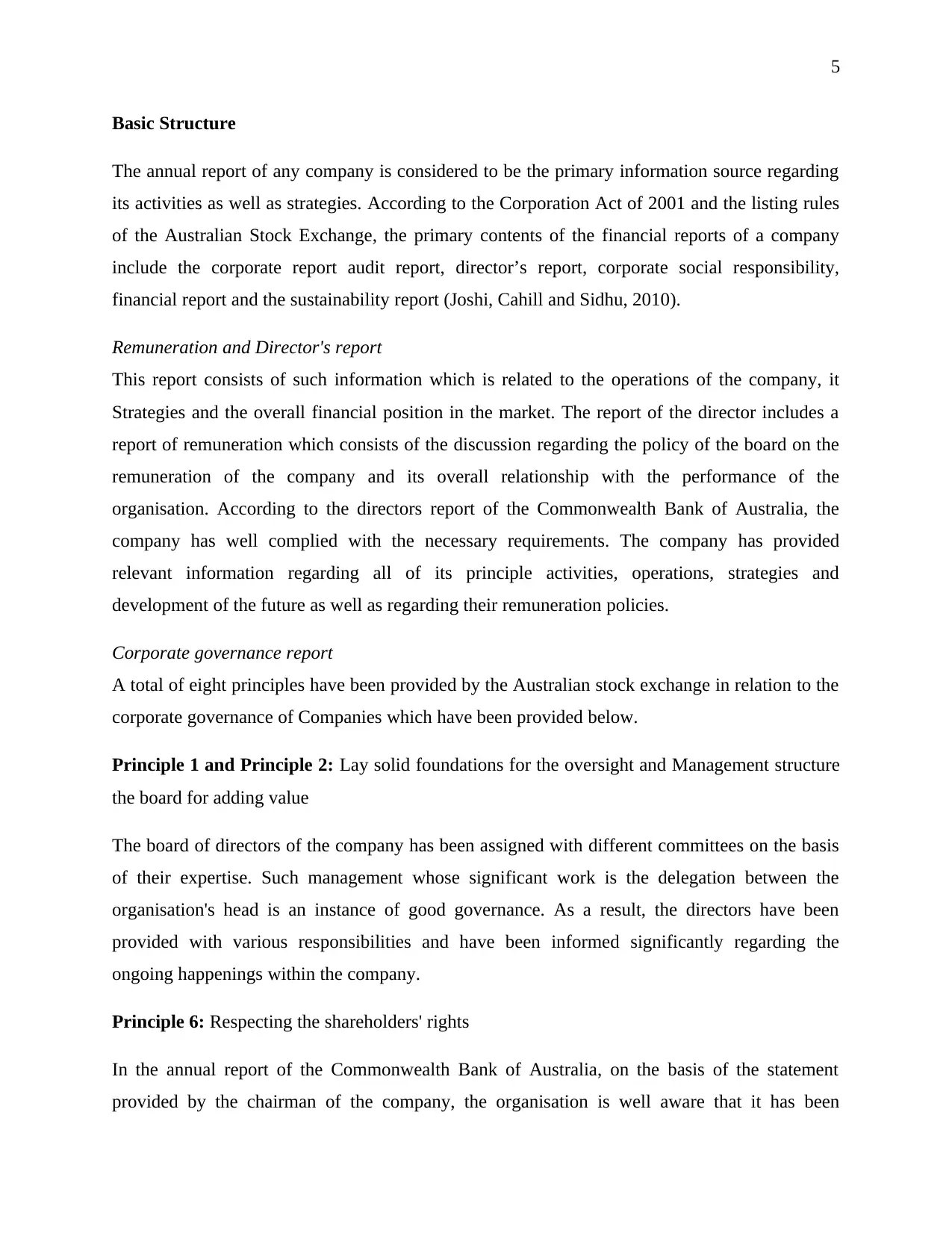
5
Basic Structure
The annual report of any company is considered to be the primary information source regarding
its activities as well as strategies. According to the Corporation Act of 2001 and the listing rules
of the Australian Stock Exchange, the primary contents of the financial reports of a company
include the corporate report audit report, director’s report, corporate social responsibility,
financial report and the sustainability report (Joshi, Cahill and Sidhu, 2010).
Remuneration and Director's report
This report consists of such information which is related to the operations of the company, it
Strategies and the overall financial position in the market. The report of the director includes a
report of remuneration which consists of the discussion regarding the policy of the board on the
remuneration of the company and its overall relationship with the performance of the
organisation. According to the directors report of the Commonwealth Bank of Australia, the
company has well complied with the necessary requirements. The company has provided
relevant information regarding all of its principle activities, operations, strategies and
development of the future as well as regarding their remuneration policies.
Corporate governance report
A total of eight principles have been provided by the Australian stock exchange in relation to the
corporate governance of Companies which have been provided below.
Principle 1 and Principle 2: Lay solid foundations for the oversight and Management structure
the board for adding value
The board of directors of the company has been assigned with different committees on the basis
of their expertise. Such management whose significant work is the delegation between the
organisation's head is an instance of good governance. As a result, the directors have been
provided with various responsibilities and have been informed significantly regarding the
ongoing happenings within the company.
Principle 6: Respecting the shareholders' rights
In the annual report of the Commonwealth Bank of Australia, on the basis of the statement
provided by the chairman of the company, the organisation is well aware that it has been
Basic Structure
The annual report of any company is considered to be the primary information source regarding
its activities as well as strategies. According to the Corporation Act of 2001 and the listing rules
of the Australian Stock Exchange, the primary contents of the financial reports of a company
include the corporate report audit report, director’s report, corporate social responsibility,
financial report and the sustainability report (Joshi, Cahill and Sidhu, 2010).
Remuneration and Director's report
This report consists of such information which is related to the operations of the company, it
Strategies and the overall financial position in the market. The report of the director includes a
report of remuneration which consists of the discussion regarding the policy of the board on the
remuneration of the company and its overall relationship with the performance of the
organisation. According to the directors report of the Commonwealth Bank of Australia, the
company has well complied with the necessary requirements. The company has provided
relevant information regarding all of its principle activities, operations, strategies and
development of the future as well as regarding their remuneration policies.
Corporate governance report
A total of eight principles have been provided by the Australian stock exchange in relation to the
corporate governance of Companies which have been provided below.
Principle 1 and Principle 2: Lay solid foundations for the oversight and Management structure
the board for adding value
The board of directors of the company has been assigned with different committees on the basis
of their expertise. Such management whose significant work is the delegation between the
organisation's head is an instance of good governance. As a result, the directors have been
provided with various responsibilities and have been informed significantly regarding the
ongoing happenings within the company.
Principle 6: Respecting the shareholders' rights
In the annual report of the Commonwealth Bank of Australia, on the basis of the statement
provided by the chairman of the company, the organisation is well aware that it has been
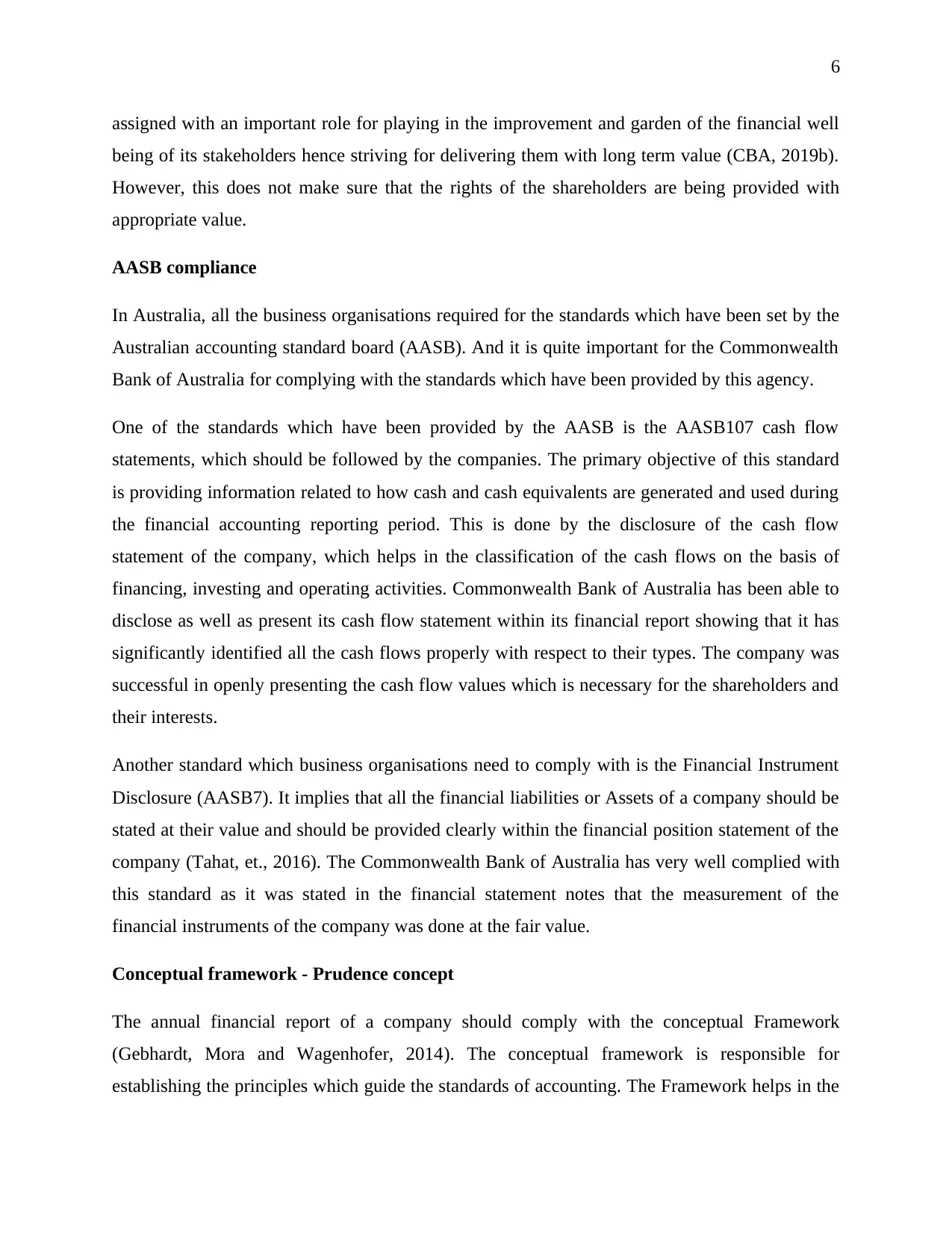
6
assigned with an important role for playing in the improvement and garden of the financial well
being of its stakeholders hence striving for delivering them with long term value (CBA, 2019b).
However, this does not make sure that the rights of the shareholders are being provided with
appropriate value.
AASB compliance
In Australia, all the business organisations required for the standards which have been set by the
Australian accounting standard board (AASB). And it is quite important for the Commonwealth
Bank of Australia for complying with the standards which have been provided by this agency.
One of the standards which have been provided by the AASB is the AASB107 cash flow
statements, which should be followed by the companies. The primary objective of this standard
is providing information related to how cash and cash equivalents are generated and used during
the financial accounting reporting period. This is done by the disclosure of the cash flow
statement of the company, which helps in the classification of the cash flows on the basis of
financing, investing and operating activities. Commonwealth Bank of Australia has been able to
disclose as well as present its cash flow statement within its financial report showing that it has
significantly identified all the cash flows properly with respect to their types. The company was
successful in openly presenting the cash flow values which is necessary for the shareholders and
their interests.
Another standard which business organisations need to comply with is the Financial Instrument
Disclosure (AASB7). It implies that all the financial liabilities or Assets of a company should be
stated at their value and should be provided clearly within the financial position statement of the
company (Tahat, et., 2016). The Commonwealth Bank of Australia has very well complied with
this standard as it was stated in the financial statement notes that the measurement of the
financial instruments of the company was done at the fair value.
Conceptual framework - Prudence concept
The annual financial report of a company should comply with the conceptual Framework
(Gebhardt, Mora and Wagenhofer, 2014). The conceptual framework is responsible for
establishing the principles which guide the standards of accounting. The Framework helps in the
assigned with an important role for playing in the improvement and garden of the financial well
being of its stakeholders hence striving for delivering them with long term value (CBA, 2019b).
However, this does not make sure that the rights of the shareholders are being provided with
appropriate value.
AASB compliance
In Australia, all the business organisations required for the standards which have been set by the
Australian accounting standard board (AASB). And it is quite important for the Commonwealth
Bank of Australia for complying with the standards which have been provided by this agency.
One of the standards which have been provided by the AASB is the AASB107 cash flow
statements, which should be followed by the companies. The primary objective of this standard
is providing information related to how cash and cash equivalents are generated and used during
the financial accounting reporting period. This is done by the disclosure of the cash flow
statement of the company, which helps in the classification of the cash flows on the basis of
financing, investing and operating activities. Commonwealth Bank of Australia has been able to
disclose as well as present its cash flow statement within its financial report showing that it has
significantly identified all the cash flows properly with respect to their types. The company was
successful in openly presenting the cash flow values which is necessary for the shareholders and
their interests.
Another standard which business organisations need to comply with is the Financial Instrument
Disclosure (AASB7). It implies that all the financial liabilities or Assets of a company should be
stated at their value and should be provided clearly within the financial position statement of the
company (Tahat, et., 2016). The Commonwealth Bank of Australia has very well complied with
this standard as it was stated in the financial statement notes that the measurement of the
financial instruments of the company was done at the fair value.
Conceptual framework - Prudence concept
The annual financial report of a company should comply with the conceptual Framework
(Gebhardt, Mora and Wagenhofer, 2014). The conceptual framework is responsible for
establishing the principles which guide the standards of accounting. The Framework helps in the
⊘ This is a preview!⊘
Do you want full access?
Subscribe today to unlock all pages.

Trusted by 1+ million students worldwide
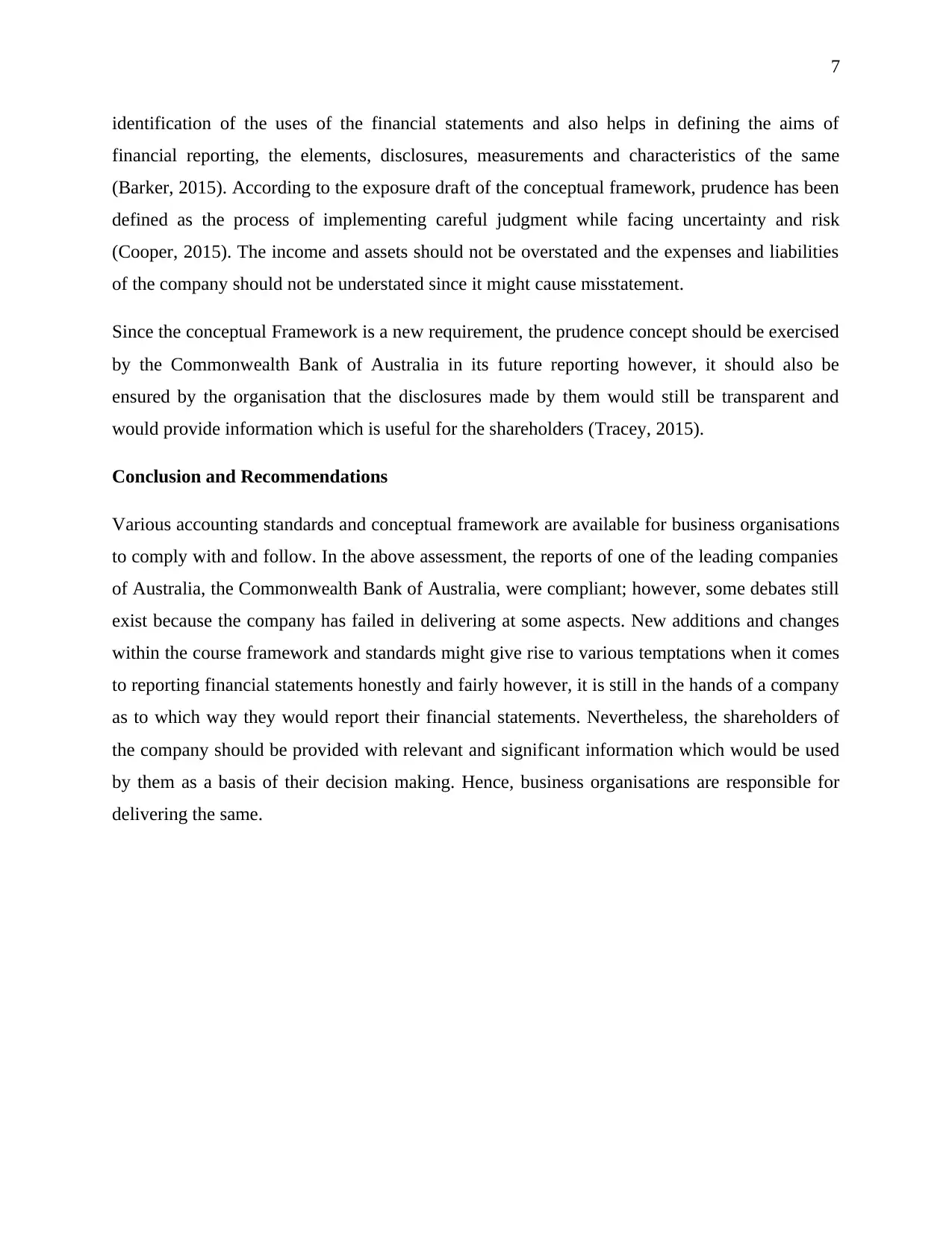
7
identification of the uses of the financial statements and also helps in defining the aims of
financial reporting, the elements, disclosures, measurements and characteristics of the same
(Barker, 2015). According to the exposure draft of the conceptual framework, prudence has been
defined as the process of implementing careful judgment while facing uncertainty and risk
(Cooper, 2015). The income and assets should not be overstated and the expenses and liabilities
of the company should not be understated since it might cause misstatement.
Since the conceptual Framework is a new requirement, the prudence concept should be exercised
by the Commonwealth Bank of Australia in its future reporting however, it should also be
ensured by the organisation that the disclosures made by them would still be transparent and
would provide information which is useful for the shareholders (Tracey, 2015).
Conclusion and Recommendations
Various accounting standards and conceptual framework are available for business organisations
to comply with and follow. In the above assessment, the reports of one of the leading companies
of Australia, the Commonwealth Bank of Australia, were compliant; however, some debates still
exist because the company has failed in delivering at some aspects. New additions and changes
within the course framework and standards might give rise to various temptations when it comes
to reporting financial statements honestly and fairly however, it is still in the hands of a company
as to which way they would report their financial statements. Nevertheless, the shareholders of
the company should be provided with relevant and significant information which would be used
by them as a basis of their decision making. Hence, business organisations are responsible for
delivering the same.
identification of the uses of the financial statements and also helps in defining the aims of
financial reporting, the elements, disclosures, measurements and characteristics of the same
(Barker, 2015). According to the exposure draft of the conceptual framework, prudence has been
defined as the process of implementing careful judgment while facing uncertainty and risk
(Cooper, 2015). The income and assets should not be overstated and the expenses and liabilities
of the company should not be understated since it might cause misstatement.
Since the conceptual Framework is a new requirement, the prudence concept should be exercised
by the Commonwealth Bank of Australia in its future reporting however, it should also be
ensured by the organisation that the disclosures made by them would still be transparent and
would provide information which is useful for the shareholders (Tracey, 2015).
Conclusion and Recommendations
Various accounting standards and conceptual framework are available for business organisations
to comply with and follow. In the above assessment, the reports of one of the leading companies
of Australia, the Commonwealth Bank of Australia, were compliant; however, some debates still
exist because the company has failed in delivering at some aspects. New additions and changes
within the course framework and standards might give rise to various temptations when it comes
to reporting financial statements honestly and fairly however, it is still in the hands of a company
as to which way they would report their financial statements. Nevertheless, the shareholders of
the company should be provided with relevant and significant information which would be used
by them as a basis of their decision making. Hence, business organisations are responsible for
delivering the same.
Paraphrase This Document
Need a fresh take? Get an instant paraphrase of this document with our AI Paraphraser
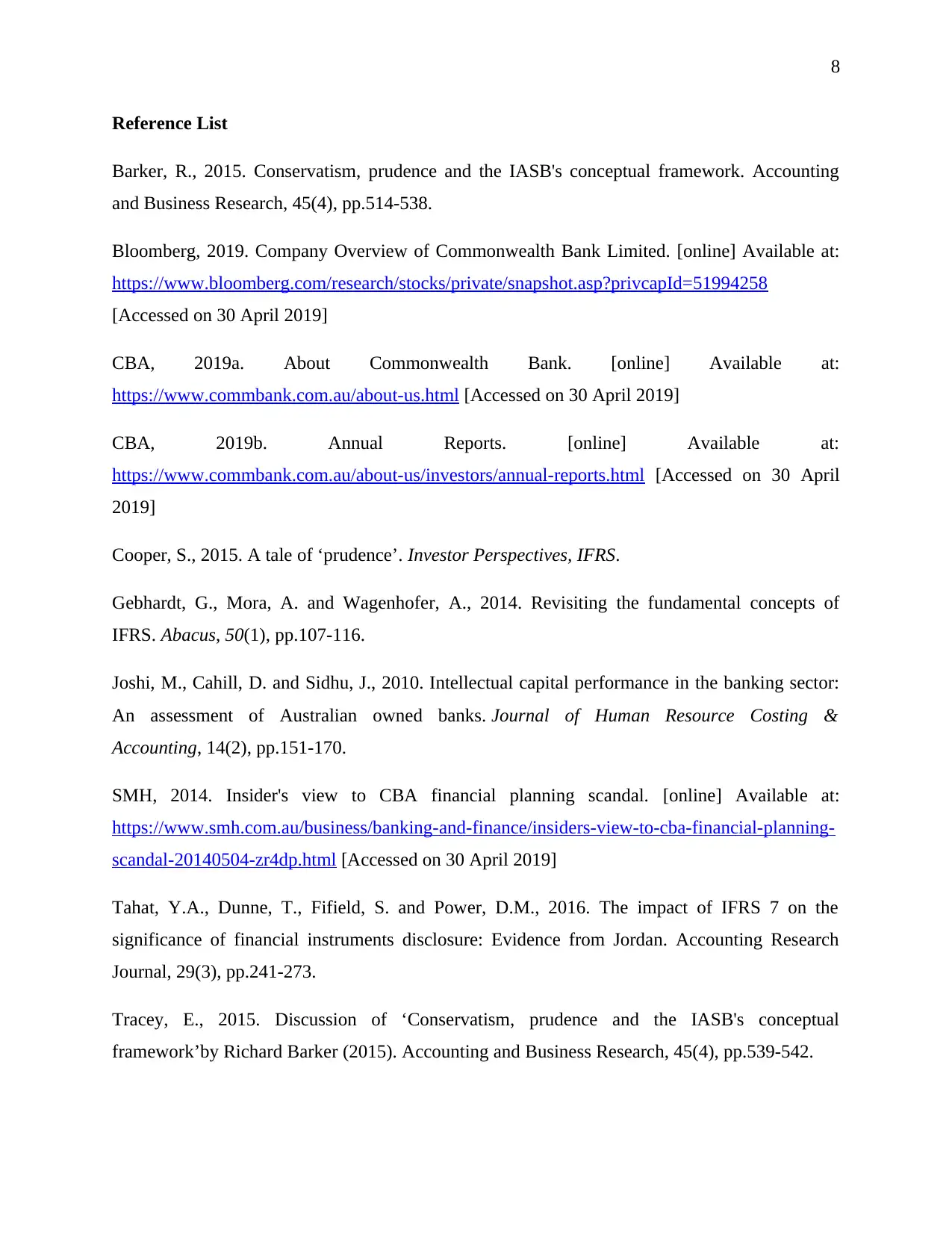
8
Reference List
Barker, R., 2015. Conservatism, prudence and the IASB's conceptual framework. Accounting
and Business Research, 45(4), pp.514-538.
Bloomberg, 2019. Company Overview of Commonwealth Bank Limited. [online] Available at:
https://www.bloomberg.com/research/stocks/private/snapshot.asp?privcapId=51994258
[Accessed on 30 April 2019]
CBA, 2019a. About Commonwealth Bank. [online] Available at:
https://www.commbank.com.au/about-us.html [Accessed on 30 April 2019]
CBA, 2019b. Annual Reports. [online] Available at:
https://www.commbank.com.au/about-us/investors/annual-reports.html [Accessed on 30 April
2019]
Cooper, S., 2015. A tale of ‘prudence’. Investor Perspectives, IFRS.
Gebhardt, G., Mora, A. and Wagenhofer, A., 2014. Revisiting the fundamental concepts of
IFRS. Abacus, 50(1), pp.107-116.
Joshi, M., Cahill, D. and Sidhu, J., 2010. Intellectual capital performance in the banking sector:
An assessment of Australian owned banks. Journal of Human Resource Costing &
Accounting, 14(2), pp.151-170.
SMH, 2014. Insider's view to CBA financial planning scandal. [online] Available at:
https://www.smh.com.au/business/banking-and-finance/insiders-view-to-cba-financial-planning-
scandal-20140504-zr4dp.html [Accessed on 30 April 2019]
Tahat, Y.A., Dunne, T., Fifield, S. and Power, D.M., 2016. The impact of IFRS 7 on the
significance of financial instruments disclosure: Evidence from Jordan. Accounting Research
Journal, 29(3), pp.241-273.
Tracey, E., 2015. Discussion of ‘Conservatism, prudence and the IASB's conceptual
framework’by Richard Barker (2015). Accounting and Business Research, 45(4), pp.539-542.
Reference List
Barker, R., 2015. Conservatism, prudence and the IASB's conceptual framework. Accounting
and Business Research, 45(4), pp.514-538.
Bloomberg, 2019. Company Overview of Commonwealth Bank Limited. [online] Available at:
https://www.bloomberg.com/research/stocks/private/snapshot.asp?privcapId=51994258
[Accessed on 30 April 2019]
CBA, 2019a. About Commonwealth Bank. [online] Available at:
https://www.commbank.com.au/about-us.html [Accessed on 30 April 2019]
CBA, 2019b. Annual Reports. [online] Available at:
https://www.commbank.com.au/about-us/investors/annual-reports.html [Accessed on 30 April
2019]
Cooper, S., 2015. A tale of ‘prudence’. Investor Perspectives, IFRS.
Gebhardt, G., Mora, A. and Wagenhofer, A., 2014. Revisiting the fundamental concepts of
IFRS. Abacus, 50(1), pp.107-116.
Joshi, M., Cahill, D. and Sidhu, J., 2010. Intellectual capital performance in the banking sector:
An assessment of Australian owned banks. Journal of Human Resource Costing &
Accounting, 14(2), pp.151-170.
SMH, 2014. Insider's view to CBA financial planning scandal. [online] Available at:
https://www.smh.com.au/business/banking-and-finance/insiders-view-to-cba-financial-planning-
scandal-20140504-zr4dp.html [Accessed on 30 April 2019]
Tahat, Y.A., Dunne, T., Fifield, S. and Power, D.M., 2016. The impact of IFRS 7 on the
significance of financial instruments disclosure: Evidence from Jordan. Accounting Research
Journal, 29(3), pp.241-273.
Tracey, E., 2015. Discussion of ‘Conservatism, prudence and the IASB's conceptual
framework’by Richard Barker (2015). Accounting and Business Research, 45(4), pp.539-542.

9
⊘ This is a preview!⊘
Do you want full access?
Subscribe today to unlock all pages.

Trusted by 1+ million students worldwide
1 out of 9
Related Documents
Your All-in-One AI-Powered Toolkit for Academic Success.
+13062052269
info@desklib.com
Available 24*7 on WhatsApp / Email
![[object Object]](/_next/static/media/star-bottom.7253800d.svg)
Unlock your academic potential
Copyright © 2020–2025 A2Z Services. All Rights Reserved. Developed and managed by ZUCOL.





